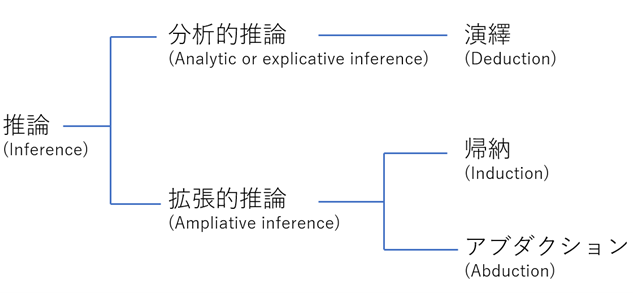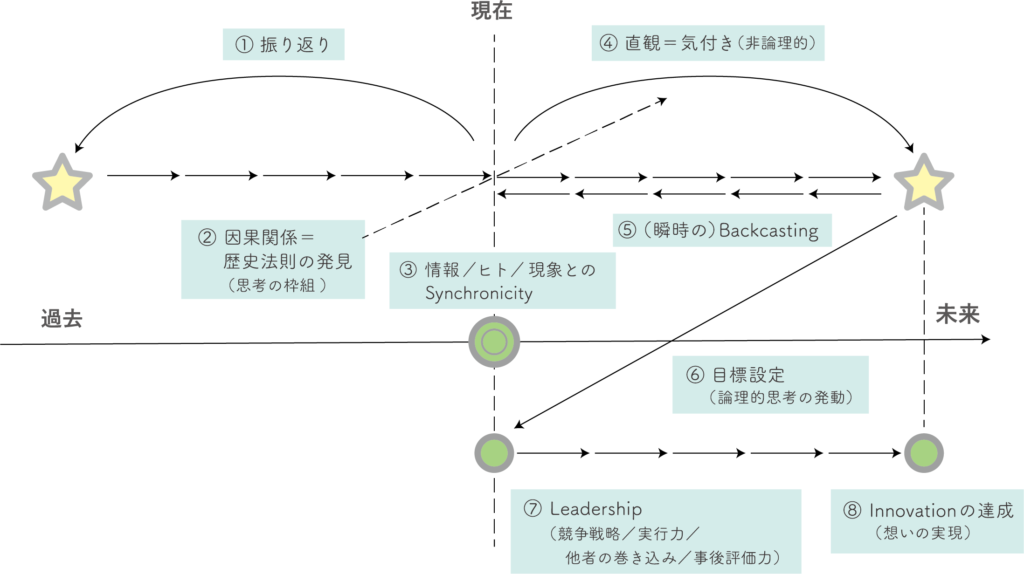Abduction, an instinctive ability that all humans possess

Have you ever heard of “Abduction”? Abduction, which I would like to discuss in this blog is one of the ways of reasoning.
There are two conventional ways of thinking (which logic has recognized as modes of argumentation or reasoning): “Deduction” and “Induction. However, a third way of thinking, abduction, has been added to these two, and it is believed that “Only through the trinity of deduction, induction, and abduction can the logic of scientific inquiry be fully elucidated.” [Yonemori 81, p199].
If you look up abduction in Japanese, you will notice that many books and articles written by a man named Yuji Yonemori are cited. Speaking of previous overviews of Peirce’s philosophy in Japan, “Peirce’s Semiotics” [Yonemori 81], “Peirce’s Pragmatism” [Ito 03], “Peirce’s Epistemology” [Davis 90], “Peirce’s Thought: Semiotics and Cognitive Linguistics” [Arima 01], and “Peirce’s Cosmology” [Ito 06] are some examples. Thus, an examination of the sources reveals a philosopher named Peirce (Charles Sanders Peirce). It is said that Peirce was not only a philosopher but also a top-notch mathematician, and that “he therefore thought like a mathematician in the field, regarded mathematics as a diagrammatic experiment and did not seek correspondences with the natural world [Corinthianity Dvar 17, p261]”. Peirce’s way of thinking seems to be closely related to that of Leibniz, who proposed the “Monadic Theory” that “everything, including matter and the human spirit, is composed of a kind of ‘mental atom'”. It seems to be related to Leibniz’s “Information Physics of Leibniz: Connecting entities and phenomena with codes [Uchii 16],” which was presented by the CEO of this Institute, Takeo Haradam, as a reading assignment of this summer).
In Peirce’s Logic of Inquiry, inferences are classified as follows.
(Figure: Peirce’s framework of reasoning)

(Created by the author with reference to “Abduction: The Logic of Hypothesis and Discovery [Yonemori07,p82]”)
As shown in the figure, we can see that “abduction” is divided into “extended reasoning” and is a way of building up alongside induction. I would like to compare these two.
【Induction】
(1) These are the beans in this bag. (Example)
(2) These beans are white. (Result)
(c) Therefore, all beans in this bag are white. (Rule)
In other words, “I took one bean out of the bag and it was white. Perhaps all the beans in this bag are white.” This is the inductive inference.
【Abduction】
(1) All beans in this bag are white. (Rule)
(2) These beans are white. (Result)
(3) Therefore, these beans are the beans in this bag. (Example)
In this case, “The beans scattered on the table are white. The bag is open and the contents can be seen; all the beans in that bag are white. Perhaps the beans on the table were spilled from that bag.” This is the inference of abduction.
Abduction differs from induction in two ways.
First, abduction infers “something of a different kind from what we directly observe. Second, abduction is a transcendental inference that leads to “something that is often not directly observable to us. [Yonemori 81, p. 193]”
Abduction is also called “Hypothetical reasoning”.
According to Peirce [Yonemori 81], there are at least three types of this hypothetical reasoning.
The first kind is for example, one encounters a person who appears to be a person of importance being escorted by horsemen through a port town in Turkey, and one thinks that this person must be the governor of the region. At the time he comes up with this hypothesis, he has not yet assimilated the person to see if he is really the governor of the region, but if he wants to, he can go directly to the governor’s office to confirm it. It is an explanatory hypothesis that refers to facts that are not yet observed at the time the abduction takes place, but that can be observed if one wishes to do so.
The second type of hypothesis refers to facts that are physically unobservable. For example, historical facts, or geological hypotheses, such as inferring from fish fossils that the land in an area was once an ocean.
The third type of hypothesis refers to facts that are not directly observable, either practically or in principle, at this stage of our scientific knowledge. For example, quantum hypotheses about elementary particles. However, not only facts such as subatomic particles, but also laws of science and other ethical objects such as energy, electromagnetic fields, nuclear forces, gravity, etc. are all hypothetical entities that are not directly observable. The third kind includes all hypotheses about such theoretical objects.
Regarding the following statement by Yonemori (1981), Osawa (2017) is skeptical, saying, “Peirce does not use words that overvalue only abduction,” but Yonemori (1981) says, “According to Peirce, this third kind of hypothesis is essentially the best scientific hypothesis and of great scientific value. (p195). The reason is that “this type of hypothesis usually implies many other important hypotheses and yields scientifically fruitful results, and second, they have the most general and universal character and can therefore explain many phenomena and the relationships among them [Yonemori 81, pp. 195-196]”.
(1) There is a remarkable fact C.
(2) But if it is A, then it is C.
(3) Therefore, it is A.
Below is written in symbols,
(1) C
(2) A⊃C
(3) A
(It is probably because of this use of symbols that the literature known as “Peirce’s Semiotics” was born.)
As can be seen from this formulation, abduction can be said to be an inference from the posterior case to the antecedent case. Yonemori (1981) states, “Abduction, in other words, commits what logic calls the fallacy of affirming the consequent[Yonemori 81, p. 198]”. By “fallacy,” he means that abduction does not have the logical necessity of formally valid laws of logic, and is a “weak kind of argument” that is highly fallible. However there, if hypothesis A does not successfully explain fact C, we can propose a new hypothesis B and consider “if B, then C”. This is a repetition of the same process.
In other words, to construct a hypothesis in this way means to derive a solution by actively asking nature from our side. However, in order to successfully elicit answers, it “requires skillful thinking [Yonemori 81, p199],” and therefore “abduction is to a large extent a logically controllable technical reasoning [Yonemori 81, p199].
In the “Diagram of Information Literacy” created by Takeo Harada, CEO of this Institute, abduction refers to the part of ④intuition = awareness (non-logical).
(Figure: Overall picture of information literacy by analogy)

(Reference: Harada 15, pp. 140-141.)
Referring to the figure, the certainty of prediction by abduction here is small because the future is the subject. The conclusion that two-thirds of the beans in the bag are white is the “best explanation” for the fact that two-thirds of the beans removed from the bag are white. However, abduction cannot lead to this kind of strong conclusion. However, at the same time, this is precisely because abduction is “the least constrained by logical rules [Corinnez-Dovall 17, p96],” and scientists, we are told, come up with correct hypotheses and make important discoveries through inspiration, insight, and intuition.
According to Peirce, the function of insight is also an important characteristic of abduction. Such a flash idea may sound irrational and like a mystical ability that only certain people can exhibit, but Peirce states that it is “an instinctive ability inherent in humans to adapt to nature [Yonemori 07, p. 69]. Takeo Harada explains that a correct understanding of the past/history is the most important for this part.
In “Peirce, Collected Works 2: Semiotics,” he writes: “Abduction is a general term that refers to the abstraction of the past”. Abduction is a method of forming a general prediction, but doing so without any positive certainty that the prediction will succeed in a particular or ordinary case, and the justification is as follows. “This is the only way in which it has any prospect of rationally regulating our future conduct, and to the hope that such a method will succeed in the future, induction from past experience gives strong encouragement [Peirce 86, pp. 26-27].”
Finally, humans can infer the future from past experience and formulate hypotheses with some degree of certainty. In a word, this is “abduction. Although the more familiar abduction was not mentioned in this article, it has been noted that “most of the inferences we make in our daily lives are abductions, and pure inductive inferences and analogies without abductions are almost non-existent [Imai, 2016].” It would be a pleasure I could give you a glimpse into the background of abduction, which is not an event completely away from us, but is also “intuition” or “awareness,” as we say at the Institute.
Chancellery Unit, Group for Project Pax Japonica, Maria Tanaka
[References]
・[Arima01]Arima Michiko,“Perth’s Thought: Semiotics and Cognitive Linguistics”,Iwanami Shoten,2001.
・[Cornelis17]Cornelis de Waal, translated by Osawa Hideyuki“For those who want to know the truth about Perth’s philosophy”,Keiso Shobo,2017.
・[Davis90]William H.Davis,“Epistemology of Peirce”,Sangyo Tosho,1990
・[Harada15]Harada Takeo,“Why do the elite who run the world use this “framework”?”,Kanki Shuppan,2015.
・[Ito03]Ito Kunitake,“Pragmatism od Peirce”, Keiso Shobo,2003.
・[Ito06]Ito Kunitake,“Cosmology of Peirce”,Iwanami Shoten,2006.
・[Imai16]Imai Mutsumi,“The role of abductive inference in word learning and constructing the lexicon”, The 33rd Annual Meeting of the Japanese Cognitive Science Society,2016,2016.
・[Peirce86]C.S.Peirce,Translated by Uchida Taneomi,“The Essential Peirce:Selected Philosophical Writings, 2 vols. ed.” Peirce Edition Project. Bloomington & Indianapolis:Indiana University Press, Japanese version from Keiso Shobo,1986.
・[Yonemori81]Yonemori Yuji,“Semiotics of Peirce”, Keiso Shobo,1981.
・[Yonemori07]Yonemori Yuji,“Abduction: The Logic of Hypothesis and Discovery”,2007



